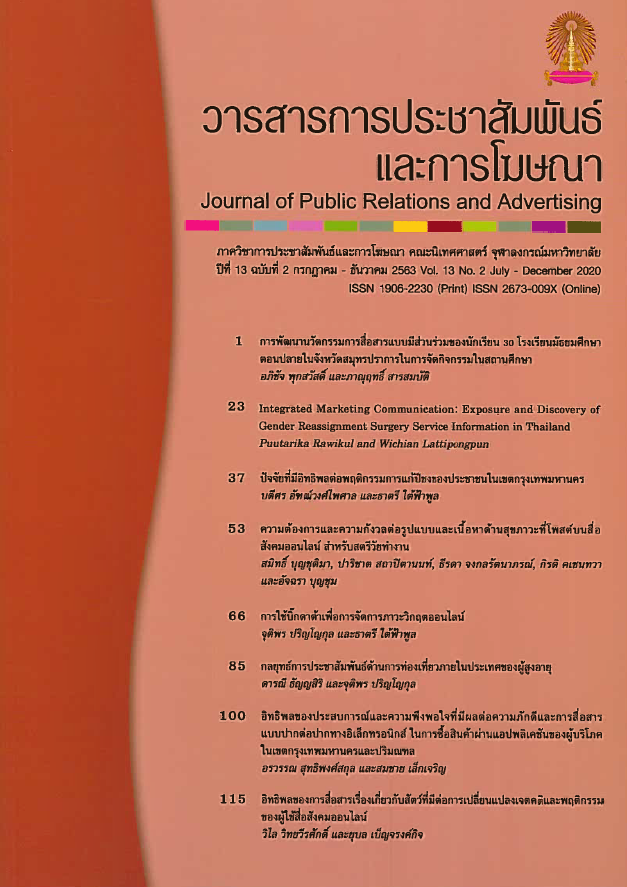The Requirement and Concern towards Health Form and Content Posted on Social Media for Working Age Women
Main Article Content
Abstract
This research aimed to 1) study the requirement and concern towards health form and content posted on social media for working age women and 2) compare the requirement and concern towards health form and content posted on social media for working age women who worked in different sectors. The quantitative research methodology was conducted, as well as utilized survey research method to collect data from those who aged 15 years old from government sector, private sector and factory/ enterprise sector in Bangkok and its vicinity which amount to 1,074 samples factory/enterprise sector reflected that they required message in form of plain text more than working age women in private sector. 2) Working age women in private sector required health information regarding before and after comparison display and providing medical information more than working age women in government sector and factory/enterprise sector. 3) Working age women in private sector required health information regarding message in terms of providing knowledge and guiding to practice more than working age women in government sector and factory/enterprise sector. While 4) Working age women in private sector were concerned about health information posted on social media was incorrect and unreliable; however, working age women in government sector were concerned towards little message volume and message might lead to abuse others.
Article Details
References
กาญจนา แก้วเทพ, ขนิษฐา นิลผึ้ง และรัตติกาล เจนจัด. (2556). สื่อสาร อาหาร สุขภาพ. กรุงเทพฯ: สำนักงานกองทุนสนับสนุนการวิจัย (สกว.).
ทัณฑกานต์ ดวงรัตน์ และกุลทิพย์ ศาสตระรุจิ. (2553). การศึกษาเปรียบเทียบบทบาทในการปฏิบัติงานและบุคลิกภาพของนักประชาสัมพันธ์ระหว่างองค์กรภาครัฐและภาคเอกชน. วารสารสุทธิปริทัศน์, 24(73), 101-127.
ณัฐกร สงคราม. (2557). การถ่ายภาพ เทคนิคและการนำไปใช้เพื่อการสื่อสาร (พิมพ์ครั้งที่ 1). กรุงเทพฯ: จุฬาลงกรณ์มหาวิทยาลัย.
นันทิกา หนูสม และวิโรจน์ สุทธิสีมา. (2562). ลักษณะของข่าวปลอมในประเทศไทยและระดับการรู้เท่าทันข่าวปลอมบนเฟซบุ๊กของผู้รับสารในเขตกรุงเทพมหานคร. วารสารนิเทศศาสตร์, 37(1), 37-45.
ประวีณา พลเขตต์ และเจษฎา ศาลาทอง. (2561). การรับรู้และการรู้เท่าทันสื่อของผู้ชมรายการชัวร์ก่อนแชร์. วารสารการสื่อสารและการจัดการ นิด้า, 4(3), 47-61.
วิรัช ลภิรัตนกุล. (2552). กลยุทธ์การประชาสัมพันธ์ในภาวะวิกฤตและการบริหารภาวะวิกฤต (พิมพ์ครั้งที่ 2). กรุงเทพฯ: จุฬาลงกรณ์มหาวิทยาลัย.
ศลิษา วงศ์ไพรินทร์ และบุหงา ชัยสุวรรณ. (2562). กระบวนการคิดเชิงออกแบบผ่านวิดีโอคอนเทนต์ โดยใช้เทคนิคการเล่าเรื่องของเฟซบุ๊กแฟนเพจ Minutevideos Thailand. วารสารนิเทศศาสตร์, 37(2), 86-98.
สมิทธิ์ บุญชุติมา และเกริดา โคตรชารี. (2559). การสื่อสารความเสี่ยง (พิมพ์ครั้งที่ 1). นนทบุรี: 21 เซ็นจูรี่.
สำนักงานกองทุนสนับสนุนการสร้างเสริมสุขภาพ (สสส.). (2554). คู่มือความสุข 8 ประการในที่ทำงาน HAPPY WORK PLACE. วันที่เข้าถึงข้อมูล 15 กันยายน 2562 แหล่งที่มา https://www.thaihealth.or.th/Content/20757คู่มือความสุข%208%20ประการในที่ทำงาน%20PLACE.html
__________________(2555). สุขภาวะองค์กรคืออะไร. วันที่เข้าถึงข้อมูล 15 กันยายน 2562 แหล่งที่มา https://www.thaihealth.or.th/Content/16872-สุขภาวะองค์กรคืออะไร.html
สุดารัตน์ ดิษยวรรธนะ จันทราวัฒนากุล. (2553). รู้เท่าทัน โซเชียลมีเดีย. ใน ธาม เชื้อสถาปนศิริ (บ.ก.), รู้ทันสื่อ (น. 234-247). กรุงเทพฯ: แผนงานสื่อสร้างสุขภาวะเด็กและเยาวชน (สสย.).
อนุพงค์ สุจริยากุล, สมิทธิ์ บุญชุติมา และกิรติ คเชนทวา. (2559). การพัฒนารูปแบบสื่อสารความเสี่ยงจากวัณโรคในพื้นที่เสี่ยงวัณโรคดื้อยาหลายขนาน: กรณีศึกษา จังหวัดชายแดนไทย-เมียนมาร์ ปี พ.ศ. 2558. วารสารวิชาการสาธารณสุข, 25(4), 571-582.
Happy 8 Menu. (2012). วันที่เข้าถึงข้อมูล 15 กันยายน 2562 แหล่งที่มา http://www.happyworkplace.com/index.php/เกี่ยวกับเรา.html
Keller, P. A., & Lehmann, D. R. (2008). Designing effective health communications: A meta-analysis. Journal of Policy and Marketing, 27(2), 117-130.
Lambert, J. (2007). Digital storytelling: How digital media help preserve cultures. The Futurist, 41(2), 25.
Langer, A., Meleis, A., Knaul, F. M., Atun, R., Aran, M., Arreola-Ornelas, H., . . . Caglia, J. M. (2015). Women and health: the key for sustainable development. The Lancet, 386(9999), 1165-1210.
Mainuddin, A., Begum, H. A., Rawal, L. B., Islam, A., & Islam, S. S. (2015). Women empowerment and its relation with health seeking behavior in Bangladesh. Journal of family & reproductive health, 9(2), 65-73.
Mena, P. (2017). Why people share fake news. Retrieved September 15, 2019, from https://www.jou.ufl.edu/insights/people-share-fake-news/
Ofcom. (2017). Children and parents: Media use and attitudes report 2017. Retrieved September 15, 2019, from https://www.ofcom.org.uk/about-ofcom/latest/media/media-releases/2017/children-social-media-fake-news
Ratzan, S. C. (1998). Health communication goals. In A. Franklin (Ed.), The WHO European Health Communication Network Consultation on Health and Environment Communication Policy (pp. 35-39). Moscow, Russia.
Smith, K. H., & Syutts, M. A. (2003). Effects of short-term cosmetic versus long-term health fear appeals in anti-smoking advertisements on the smoking behaviour of adolescents. Journal of Consumer Behaviour, 3(2), 157-177.
Tennant, B., Stellefson, M., Dodd, V., Chaney, B., Chaney, D., Paige, S., & Alber, J. (2015). eHealth literacy and Web 2.0 health information seeking behaviors among baby boomers and older adults. Journal of Medical Internet Research, 17(3). doi: 10.2196/jmir.3992.
Turner, J. W. (2003). Telemedicine: Expanding health care into virtual environments. In T. L. Thompson, A. Dorsey, K. I. Miller & R. Parrot (Eds.), Handbook of health communication (pp. 515-535). New York-London: Lawrence Erlbaum Associates.
Wilson, C., Grizzle, A., Tuazon, R., Akyempong, K., & Cheung, C. (2011). Unifying notions of media and information literacy. Paris: United Nations Educational, Scientific and Cultural Organization (UNESCO).


